Abstract
The plasma concentration of a pituitary hormone is determined by the rate of secretion, degradation, and the volume of distribution of that hormone. Using a radioimmunoassay for human thyrotropin (TSH) and human TSH-131I, we have estimated the rates of degradation and distribution of TSH in man and calculated the rate of secretion. Either 0.5 or 5 μg of TSH-131I with specific activities of 1 to 50 μc per μg was administered intravenously to 12 euthyroid subjects. Serial determinations were made of TSH-131I, and the half-time of disappearance (t½) was thus estimated. The average t½ in euthyroid subjects was 53.9 minutes with a volume of distribution averaging 5.8% of body weight. The mean endogenous plasma TSH concentration was 1.8 mμg per ml (2.7 μU per ml in terms of the human TSH reference standard A). The mean total TSH pool, excluding the pituitary, was 5.8 μg (8.7 mU). From these data the mean secretion rate of TSH in euthyroid man was calculated to be 110.1 μg per day (165.2 mU).
Similar data were estimated for 3 mildly hypothyroid patients. The t½ were 75.1, 97.1, and 83.6 minutes, with a mean of 85.3 minutes (1.6 times normal). The mean TSH pool was 58.1 μg (10 times normal). The secretion rate was 688.7 μg per day (1,033.1 mU). In other hypothyroid patients, plasma TSH levels ranging from 6 to 230 mμg per ml (9 to 345 μU) have been found. If similar half-times and a normal distribution volume are assumed, the secretion rate of TSH in hypothyroid patients can be estimated to range from about 260 to 15,350 μg per day (390 to 23,025 mU) or from about 2 to 307 times normal. Therefore, the elevated plasma TSH levels found in hypothyroidism are a result of both slower degradation and increase in rate of secretion.
Full text
PDF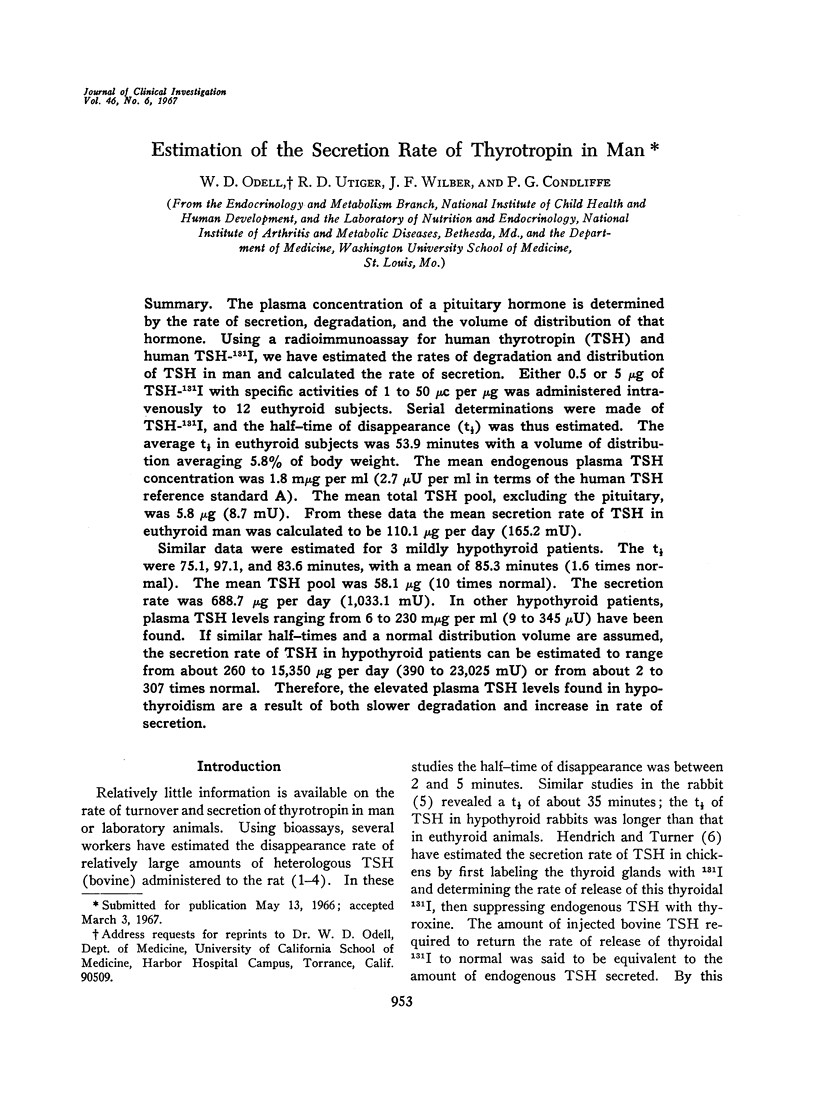
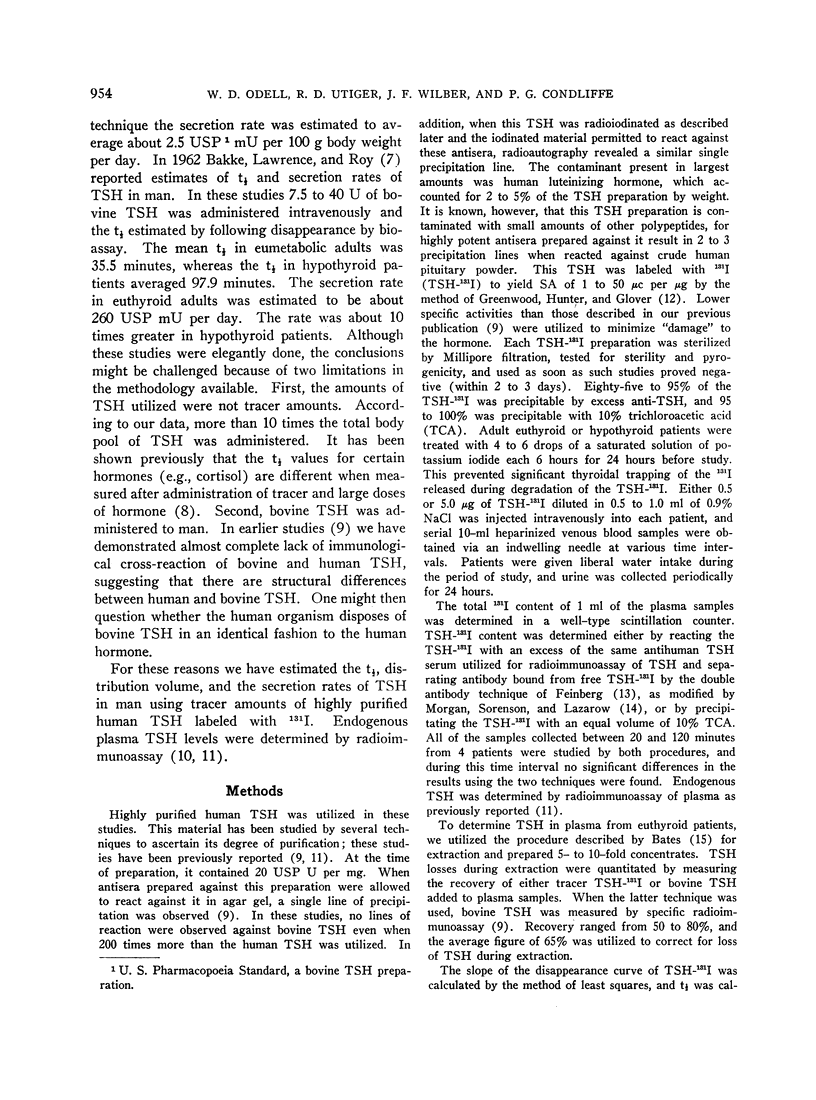
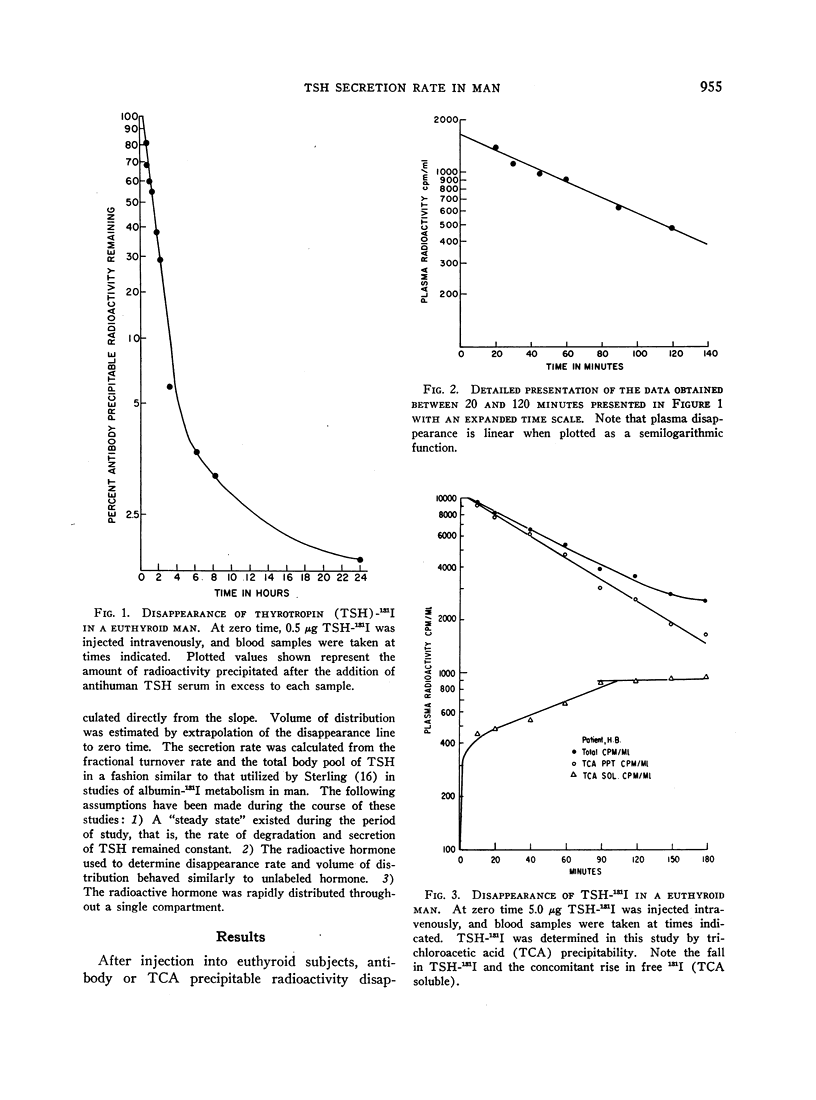
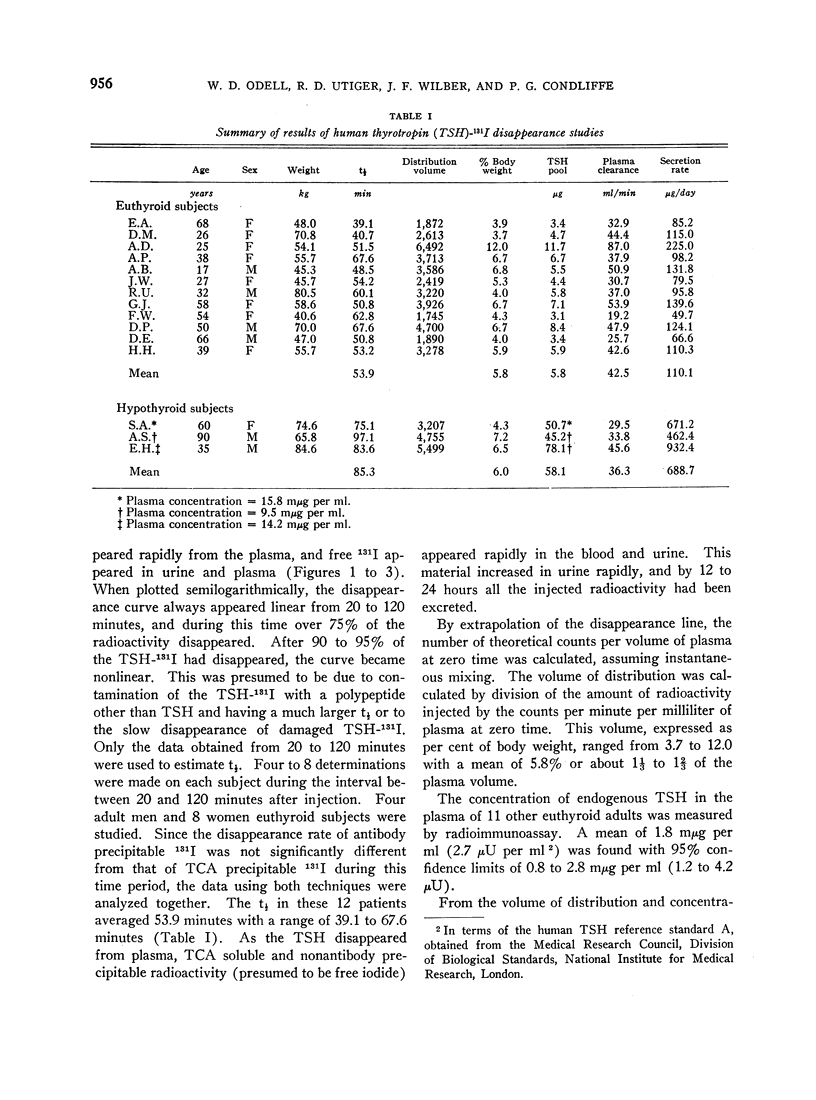
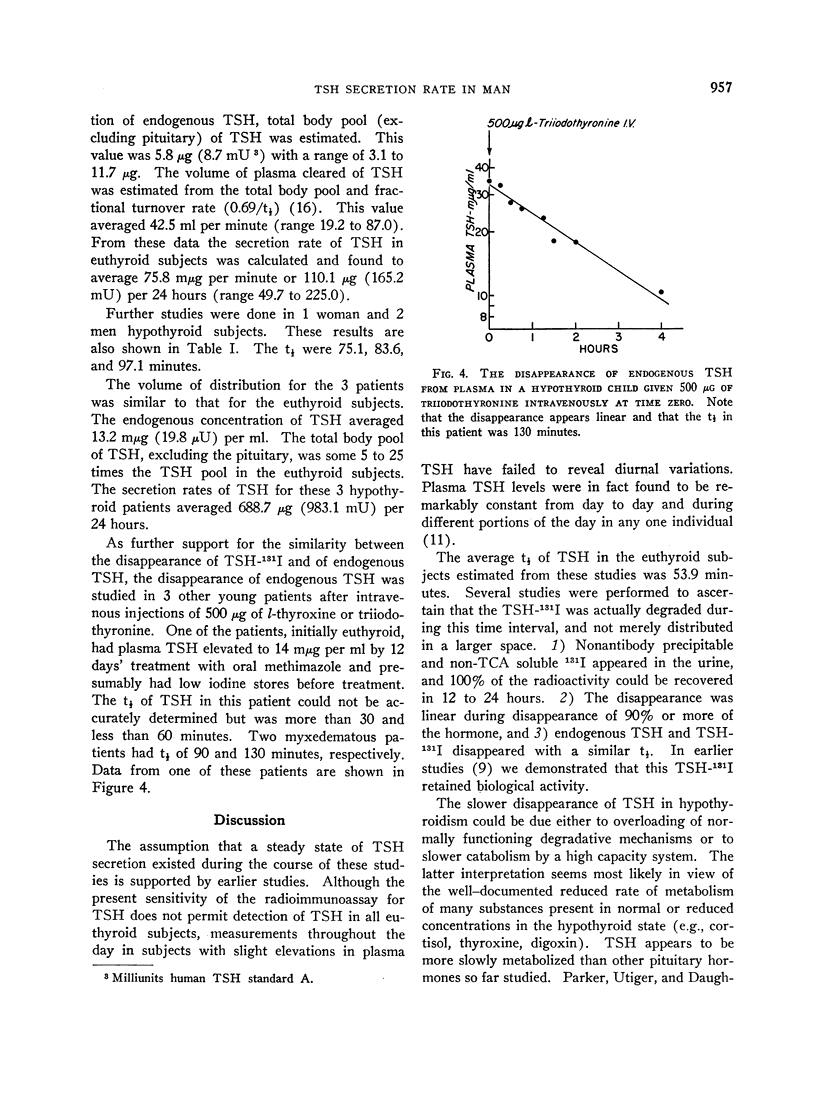
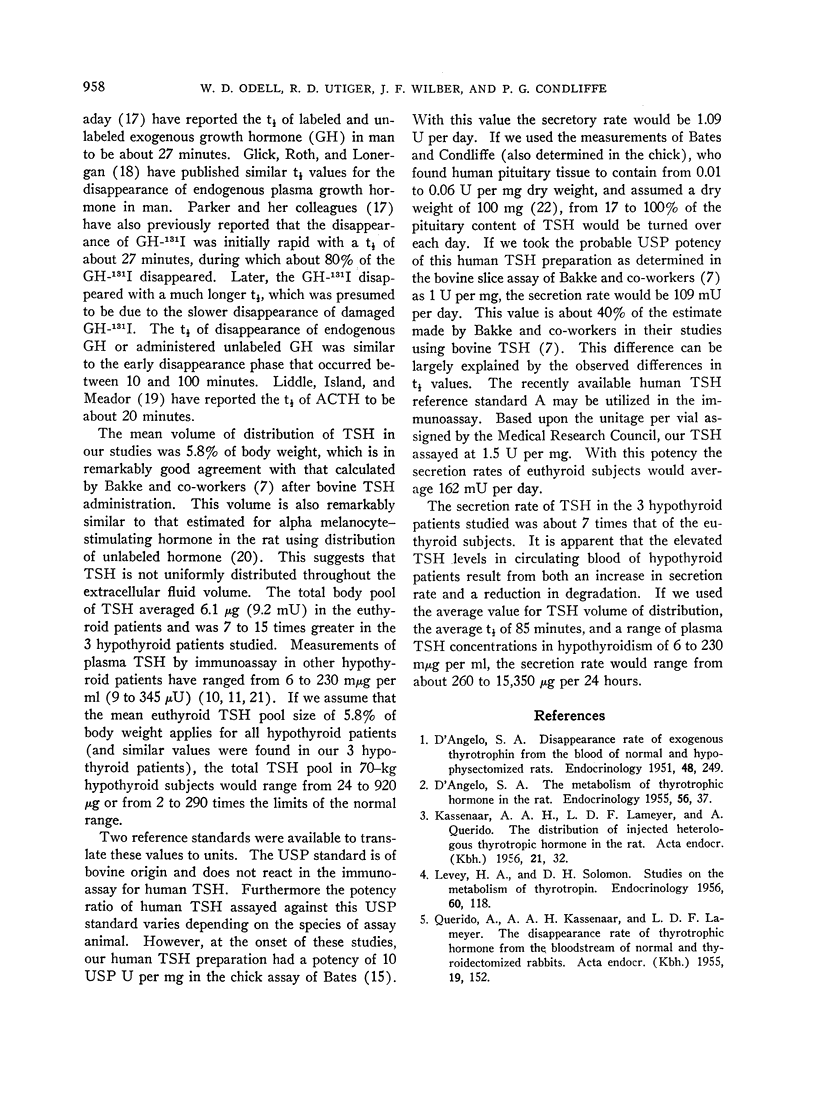
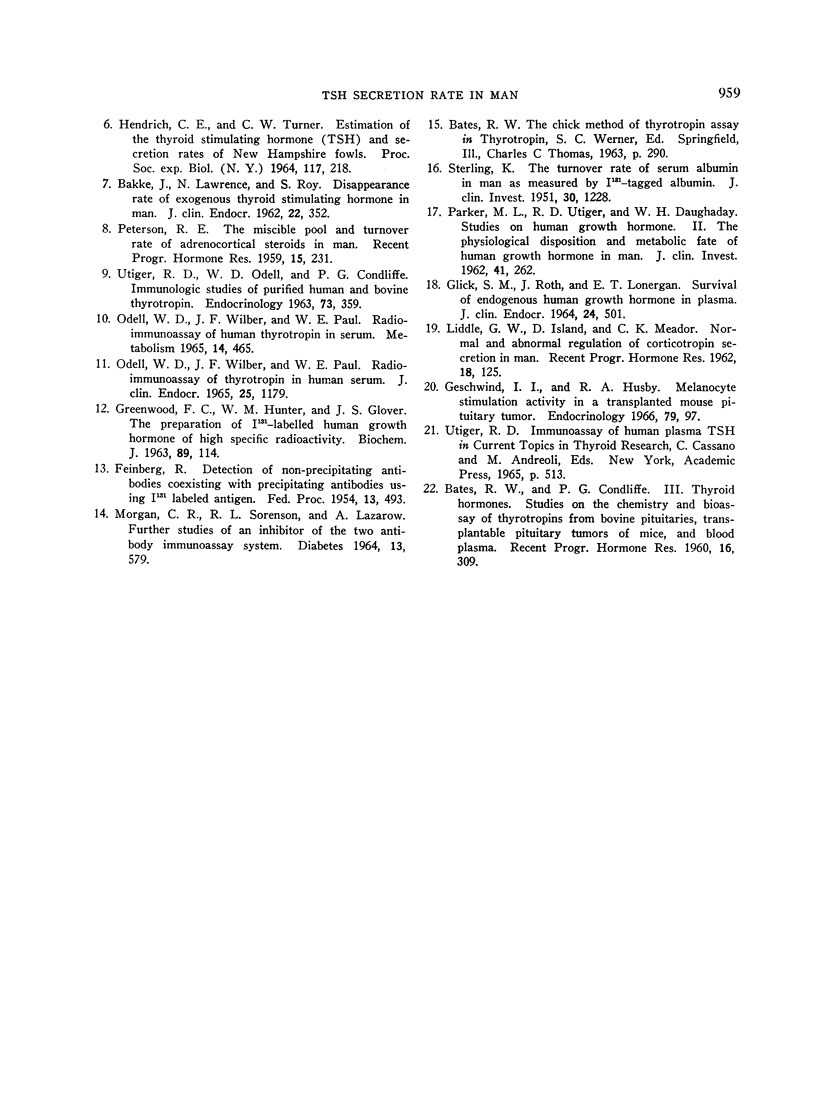
Selected References
These references are in PubMed. This may not be the complete list of references from this article.
- BAKKE J., LAWRENCE N., ROY S. Disappearance rate of exogenous thyroid-stimulating hormone (TSH) in man. J Clin Endocrinol Metab. 1962 Apr;22:352–363. doi: 10.1210/jcem-22-4-352. [DOI] [PubMed] [Google Scholar]
- BATES R. W., CONDLIFFE P. G. Studies on the chemistry and bioassay of thyrotropins from bovine pituitaries, transplantable pituitary tumors of mice, and blood plasma. Recent Prog Horm Res. 1960;16:309–352. [PubMed] [Google Scholar]
- D'ANGELO S. A. Disappearance rate of exogenous thyrotrophin from the blood of normal and hypophysectomized rats. Endocrinology. 1951 Mar;48(3):249–256. doi: 10.1210/endo-48-3-249. [DOI] [PubMed] [Google Scholar]
- D'ANGELO S. A. The metabolism of thyrotrophic hormone in the rat. Endocrinology. 1955 Jan;56(1):37–45. doi: 10.1210/endo-56-1-37. [DOI] [PubMed] [Google Scholar]
- GLICK S. M., ROTH J., LONERGAN E. T. SURVIVAL OF ENDOGENOUS HUMAN GROWTH HORMONE IN PLASMA. J Clin Endocrinol Metab. 1964 Jun;24:501–505. doi: 10.1210/jcem-24-6-501. [DOI] [PubMed] [Google Scholar]
- GREENWOOD F. C., HUNTER W. M., GLOVER J. S. THE PREPARATION OF I-131-LABELLED HUMAN GROWTH HORMONE OF HIGH SPECIFIC RADIOACTIVITY. Biochem J. 1963 Oct;89:114–123. doi: 10.1042/bj0890114. [DOI] [PMC free article] [PubMed] [Google Scholar]
- Geschwind I. I., Huseby R. A. Melanocyte-stimulating activity in a transplantable mouse pituitary tumor. Endocrinology. 1966 Jul;79(1):97–105. doi: 10.1210/endo-79-1-97. [DOI] [PubMed] [Google Scholar]
- HENDRICH C. E., TURNER C. W. ESTIMATION OF THYROID-STIMULATING HORMONE (TSH) SECRETION RATES OF NEW HAMPSHIRE FOWLS. Proc Soc Exp Biol Med. 1964 Oct;117:218–222. doi: 10.3181/00379727-117-29540. [DOI] [PubMed] [Google Scholar]
- KASSENAAR A. A., LAMEYER L. D., QUERIDO A. The distribution of injected heterologous thyrotrophic hormone in the rat. Acta Endocrinol (Copenh) 1956 Jan;21(1):32–36. doi: 10.1530/acta.0.0210032. [DOI] [PubMed] [Google Scholar]
- LEVEY H. A., SOLOMON D. H. Studies on the metabolism of thyrotropin. Endocrinology. 1957 Jan;60(1):118–129. doi: 10.1210/endo-60-1-118. [DOI] [PubMed] [Google Scholar]
- MORGAN C. R., SORENSON R. L., LAZAROW A. FURTHER STUDIES OF AN INHIBITOR OF THE TWO ANTIBODY IMMUNOASSAY SYSTEM. Diabetes. 1964 Nov-Dec;13:579–584. doi: 10.2337/diab.13.6.579. [DOI] [PubMed] [Google Scholar]
- ODELL W. D., WILBER J. F., PAUL W. E. RADIOIMMUNOASSAY OF HUMAN THYROTROPIN IN SERUM. Metabolism. 1965 Apr;14:465–467. doi: 10.1016/0026-0495(65)90036-3. [DOI] [PubMed] [Google Scholar]
- Odell W. D., Wilber J. F., Paul W. E. Radioimmunoassay of thyrotropin in human serum. J Clin Endocrinol Metab. 1965 Sep;25(9):1179–1188. doi: 10.1210/jcem-25-9-1179. [DOI] [PubMed] [Google Scholar]
- PARKER M. L., UTIGER R. D., DAUGHADAY W. H. Studies on human growth hormone. II. The physiological disposition and metabolic fate of human growth hormone in man. J Clin Invest. 1962 Feb;41:262–268. doi: 10.1172/JCI104479. [DOI] [PMC free article] [PubMed] [Google Scholar]
- QUERIDO A., KASSENAAR A. A., LAMEYER L. D. The disappearance rate of thyrotrophic hormone from the bloodstream of normal and thyroidectomized rabbits. Acta Endocrinol (Copenh) 1955 Jun;19(2):152–156. doi: 10.1530/acta.0.0190152. [DOI] [PubMed] [Google Scholar]
- STERLING K. The turnover rate of serum albumin in man as measured by I131-tagged albumin. J Clin Invest. 1951 Nov;30(11):1228–1237. doi: 10.1172/JCI102542. [DOI] [PMC free article] [PubMed] [Google Scholar]
- UTIGER R. D., ODELL W. D., CONDLIFFE P. G. IMMUNOLOGIC STUDIES OF PURIFIED HUMAN AND BOVINE THYROTROPIN. Endocrinology. 1963 Sep;73:359–365. doi: 10.1210/endo-73-3-359. [DOI] [PubMed] [Google Scholar]


